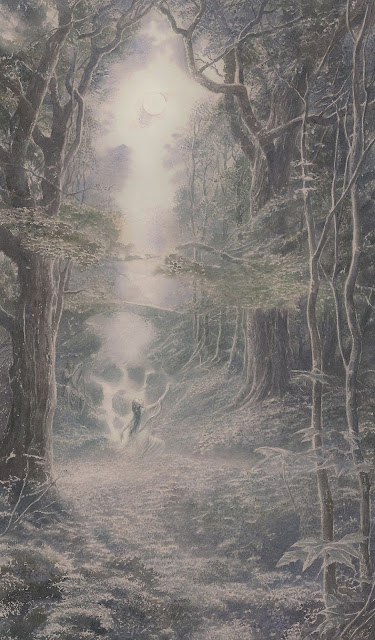This print captures the mood of early morning in the Shibaimachi, the theatre district of Tokyo, where a night of entertainment is coming to an end. The stylish lady seems to be in a hurry. Elegant silhouettes can be seen in the background, probably on their way home. The promenaders have jackets over their kimonos and the lady in the foreground wears several layers of clothes, to the early morning air must be brisk. The lady's blackened teeth and her hairstyle suggest that she is married. Her underlip is green, a detail often found in ukiyo-e prints with an aesthetic appeal that made it fashionable at the time. The sky has the purple glow of sunrise and the flatness of the colours suggest a misty air.
via |
| Algernon Cecil Newton - Winter Moonrise, Yorkshire, 1945 |
Van Gogh painted The Starry Night during his 12-month stay at the Saint-Paul-de-Mausole asylum near Saint-Rémy-de-Provence, France, several months after suffering a breakdown in which he severed a part of his own ear with a razor. While at the asylum, he painted during bursts of productivity that alternated with moods of despair.
At the asylum, van Gogh observed the night sky from his barred bedroom window and wrote a letter to Theo describing a magnificent view of the morning star very early one morning in the summer of 1889. Because he was not allowed to paint in his bedroom, he painted the scene from memory or possibly drawings and used his imagination for the small village that did not actually exist.
The oil-on-canvas painting is dominated by a night sky roiling with chromatic blue swirls, a glowing yellow crescent moon, and stars rendered as radiating orbs. One or two cypress trees, often described as flame-like, tower over the foreground to the left, their dark branches curling and swaying to the movement of the sky that they partly obscure. Amid all this animation, a structured village sits in the distance on the lower right of the canvas. Straight controlled lines make up the small cottages and the slender steeple of a church, which rises as a beacon against rolling blue hills. The glowing yellow squares of the houses suggest the welcoming lights of peaceful homes, creating a calm corner amid the painting’s turbulence.
via
Aert van der Neer initially painted realistic tonal landscapes and winter scenes, but by the late 1640s, he developed his own specialty of nocturnes, or night scenes. These mysteriously dark, moonlit pictures established him as an innovative and important landscape painter.
Van der Neer used his consummate technical skills to create this nocturne’s radiance by applying multiple layers of translucent and opaque paint. Here, the luminous clouds have parted to reveal a full moon over a tranquil stream. The moonlight reflects off the water that separates the town at left from the village and the country estate with its ornate gate at right. The light glints off window panes, shines upon a fashionable couple in conversation by the gate, and provides safe passage for the people crossing the stone bridge.
via
 |
| Shoda Koho - Fishboat on moonlit Sea |
 |
Shoda Koho - Shrine Gate at Miyajima (Itsukushima Shrine) c. 1910-20
|
A painterly interpretation of the River Thames and Greenwich Hospital by moonlight. Like his father, Abraham 'Moonlight' Pether of Chichester, Henry Pether specialised in moonlight scenes. He was famed for his views of the Thames and this painting of Greenwich Hospital, seen from the west, is a particularly fine example of his topographical work. The foreground and architectural details are carefully studied and delineated, and the moonlight reflected from the Thames illuminates the scene.
via
 |
| Alan Lee - Luthien |
The 1870s was arguably Grimshaw's most successful decade, where his sublime nocturnes, dubbed 'moonlights' began to seal the reputation that lasts to this day. In this prime example he delineates the outlines of the trees and branches, throwing them into relief by the light of the moonlit sky. The moon, veiled in thin cloud pours a dense silver across the landscape, throwing multiple reflections from the surface of the mirroring lake, and effusing the sky with a phosphorescence: a product of Grimshaw's keen sense of light and atmosphere.
Grimshaw was arguably the most evocative painter of moonlight and evening scenes, managing to perfectly portray the 'gloaming' that captured much of the poetic imagination and English romantic zeitgeist of the age, feeding the enormous appetite the Victorians had for such mood.
via
In this atmospheric image, a lone woman in a flowing gown stands in a garden under a moonlit sky. The colors are dark and mysterious. To the right of the picture is the edge of a railing. Trees frame the landscape’s view and the reflection of the glowing moon. Romantic and poetic images like this were popular in the late 1800s. We cannot see the woman’s face, but we watch her contemplate the beautiful scene from afar and wonder what she is thinking. Inness uses lighting and color to create a calm, quiet, yet dramatic, mood.
via

















No comments:
Post a Comment